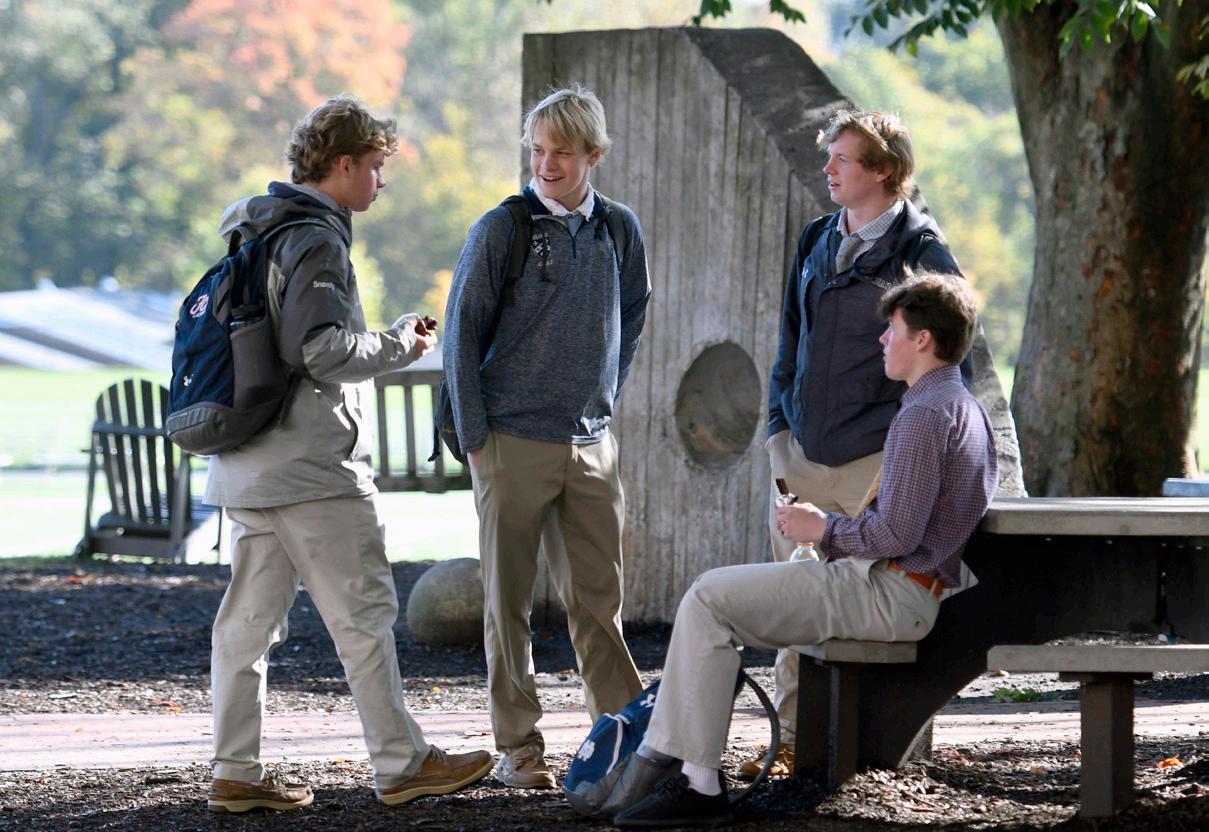1. SCHOOLS FOR BOYS UNDERSTAND AND CELEBRATE BOYS.
Schools that make the intentional choice to focus on the intellectual, physical, social, and emotional lives of boys and young men share an appreciation for the intensity and complexity of boyhood.

With years of experience, and in collaboration with their peers, teachers encourage their students to grow and mature at their own pace, using strategies that address learning styles specific to boys. They understand the different worlds of the primary school boy and the young man preparing for college. And they strive to support each individual’s needs and aspirations.
These schools recognize that boys most often are physically active, competitive, and apt to take risks-characteristics that are channeled into their learning experience. Many schools use flexible schedules and class times that permit students to move around throughout the day. Educators stimulate a boy’s interests with a mix of academics, arts, music, or athletics to continuously engage his mind and body. Faculty members also acknowledge the full range of boys’ emotions and vulnerabilities, broadening their spheres and, ultimately, fostering their ability to interact meaningfully with girls and women.


Through action research projects, teachers at member schools of the International Boys’ Schools Coalition (IBSC) continually update their knowledge of best practices in all-boys education. The IBSC offers professional development opportunities that foster a passion for educating boys.

2. SCHOOLS FOR BOYS SEEK FIRST TO BUILD GOOD MEN.
In addition to pursuing high academic achievement, schools for boys share many broad goals: to promote well-being, to develop resilience and empathy, and to see that each student achieves his potential. But none is more important than the essential goal of building good character and, by extension, of helping each boy and young man make responsible choices and live an honorable life.

A commitment to integrity and a strong ethical foundation are a school’s first priorities, and educating students about how to become a good man informs every aspect of the day. Some schools do this teaching with an official code of conduct while others have developed a formal character education curriculum.
Each initiative is strengthened by outstanding faculty who model ethical behavior daily, and also by student leaders, peer counselors, and other mentors. Boys learn that there are clear expectations to do what is right. They also learn that there are many routes to becoming a good man.
Most schools have a program of service learning that encourages students to work within the greater community to help others. At some schools, those programs are conducted with area girls’ schools, giving boys the opportunity to interact in a respectful and supportive way with their female peers.
3. SCHOOLS FOR BOYS KNOW THAT BOYS DEVELOP AND LEARN IN DIFFERENT WAYS.
It’s a simple fact that boys and girls grow at a different pace. While girls generally develop earlier physically and socially, refining their reading and writing skills sooner, boys are more spatial and visual by nature, and they demonstrate a natural affinity for areas like abstract mathematics. They are also hardwired to learn more easily through action than words.
Using fMRI (functional magnetic resonance imaging), researchers have observed differences between the developing male and female brains that demonstrate why boys and girls learn in different ways. Boys’ brains are wired to require movement, space, action, and rest. A typical coed classroom that favors verbal and auditory learning can put an active boy at a disadvantage.
One of the important advantages of a single-sex education is the opportunity it presents to create a learning environment that accommodates what boys and young men need. In a school that is boy-centered, teachers introduce more kinesthetic and sensory experiences into their curriculum, engaging boys more fully.
Educators like Abigail Norfleet James (Teaching the Male Brain: How Boys Think, Feel, and Learn in School) have translated brain theory into classroom practices for teachers of boys and young men, identifying tangible ways to address natural weaknesses as well as strengths.
4. SCHOOLS FOR BOYS TEACH IN WAYS THAT BOYS LEARN BEST.

Each faculty member in an all-boys school has made a conscious choice to teach boys. They enjoy boys’ irreverent humor, and draw energy from their natural exuberance. Their passion to teach boys requires a commitment to build relationships, craft a curriculum, and lead a classroom that engages each student in the way he learns best.



As specialists in boys’ education, teachers take into consideration the interests and talents unique to boys when they prepare each lesson. Because they know boys often prefer to work cooperatively, faculty can use teams effectively in project-based assignments. And because they understand the rhythm of a boys’ classroom, they can plan physical activity into class time and extended breaks like recess into the school day.
Classrooms filled with boys are rarely quiet. Educational researchers Michael Reichert and Richard Hawley have found that successful lessons often introduce a memorable element - a novelty, kinetic activity, game, or role play - that facilitates the intended learning outcome. Learning swordplay can make the text of Romeo and Juliet more interesting and approachable.
The work of educator Adam Cox stresses that boys need to know why something is important in order for it to have significance for them. “Boys,” he says, “thrive on purposeful work” and “relish real-time achievement,” when they are assigned tasks that give their school experience personal meaning.
5. SCHOOLS FOR
BOYS HELP STUDENTS DISCOVER AND EXPLORE THEIR FULL POTENTIAL.
Without the social pressures of a coed environment, students in an all-boys school can explore the full range of their personalities and potential. Eschewing stereotypes, they discover they have many roles to play as a scholar, athlete, artist, musician, and friend. A boys-centered school assists students in finding their innate creativity and imagination, while developing their communication skills and pursuing other strengths and interests.
Risk-takers by nature, boys find a new comfort level with nontraditional subjects and activities when they are encouraged to do so by trusted mentors within the safety of a close-knit community. Young men, who may not step up in the presence of girls, take on leadership roles at all-boys schools, often heading community service programs or serving as mentors to younger students.
Boys’ schools have a key role to play in fostering what psychologists like Michael Thompson (Raising Cain, The Pressured Child) call “emotionally literate boys,” who respond to others with empathy and compassion. Such schools appreciate that boys “will not express feelings as girls do” and provide guidance in coping with the many expectations schools, parents, or society may have for them as young men and boys.
6. SCHOOLS FOR BOYS FOSTER BROTHERHOOD AND LIFELONG FRIENDSHIPS.

Working together in the classroom, on the playing field, or in the performance hall, students are united by a special bond of brotherhood. Many boys’ school graduates say the friendships they developed with their peers and with faculty are among the most important benefits they carry with them from their schools.
Relationships are critical to a boy’s learning, according to researchers Reichert and Hawley. They report that boys thrive in an educational environment where they first establish positive, trusting relationships with teachers whose high standards and subject mastery students value.
This relationship-based education model not only enhances the learning process; it also contributes to a boy’s growing sense of belonging to his class, his team, and his school. In the outstanding teachers, coaches, and counselors who are by their sides each day, boys find important role models. Female faculty members play a key role in fostering positive, respectful attitudes toward women. These relationships also promote empathy, courage, and resilience.
This connection of brotherhood extends to a broader community of what many schools call Old Boysalumni who stand ready to positively support these young men now and in the future.
ONE OF THE IMPORTANT ADVANTAGES OF A SINGLE-SEX EDUCATION IS THE OPPORTUNITY IT PRESENTS TO CREATE A LEARNING ENVIRONMENT, LITERALLY AND FIGURATIVELY, THAT ACCOMODATES WHAT BOYS AND YOUNG MEN NEED.













